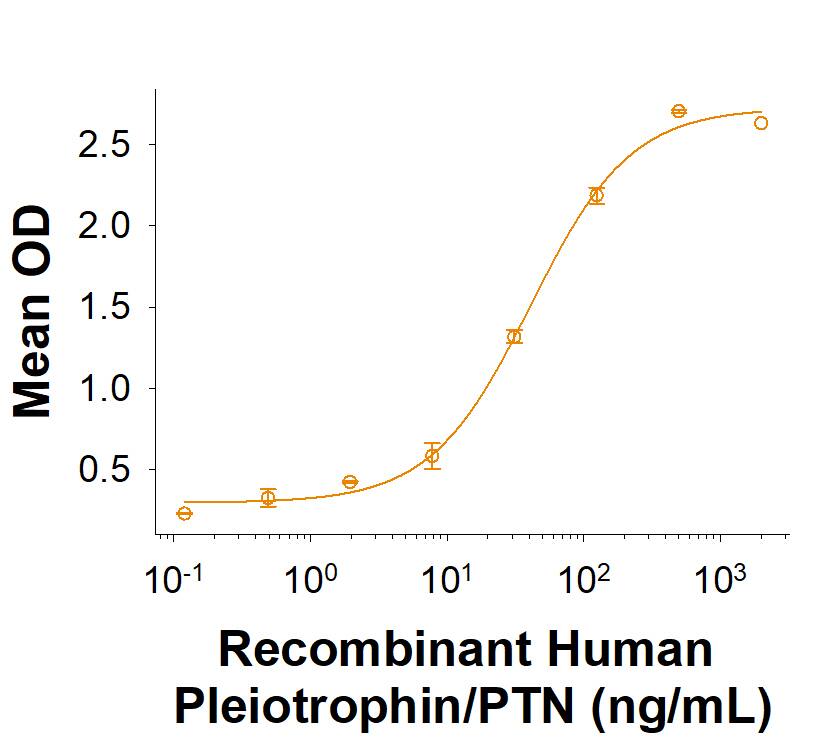Recombinant Human ALK/CD246 His-tag Protein, CF
R&D Systems, part of Bio-Techne | Catalog # 4210-CD

Key Product Details
Product Specifications
Source
Mouse myeloma cell line, NS0-derived human ALK/CD246 protein
Val19-Ser1038, with a C-terminal 6-His tag
Val19-Ser1038, with a C-terminal 6-His tag
Purity
>95%, by SDS-PAGE visualized with Silver Staining and quantitative densitometry by Coomassie® Blue Staining.
Endotoxin Level
<0.10 EU per 1 μg of the protein by the LAL method.
N-terminal Sequence Analysis
Val19
Predicted Molecular Mass
111 kDa
SDS-PAGE
130-150 kDa, under reducing conditions
Activity
Measured by its binding ability in a functional ELISA.
In a Human ALK/CD246 Antibody (Catalog # AF4210) coated plate, when Recombinant Human ALK/CD246 is present at 0.5 μg/mL, Recombinant Human Pleiotrophin/PTN (Catalog # 252-PL) binds with an ED50 of 20-100 ng/mL.
In a Human ALK/CD246 Antibody (Catalog # AF4210) coated plate, when Recombinant Human ALK/CD246 is present at 0.5 μg/mL, Recombinant Human Pleiotrophin/PTN (Catalog # 252-PL) binds with an ED50 of 20-100 ng/mL.
Scientific Data Images for Recombinant Human ALK/CD246 His-tag Protein, CF
2 μg/lane of Recombinant Human ALK.CD246 His-tag (Catalog # 4210-CD) was resolved with SDS-PAGE under reducing (R) and non-reducing (NR) conditions and visualized by Coomassie® Blue staining, showing bands at 130-150 kDa.
Formulation, Preparation and Storage
4210-CD
| Formulation | Lyophilized from a 0.2 μm filtered solution in PBS. |
| Reconstitution |
Reconstitute at 500 μg/mL in PBS.
|
| Shipping | The product is shipped at ambient temperature. Upon receipt, store it immediately at the temperature recommended below. |
| Stability & Storage | Use a manual defrost freezer and avoid repeated freeze-thaw cycles.
|
Background: ALK/CD246
References
- Chiarle, R. et al. (2008) Nat. Rev. Cancer 8:11.
- Allouche, M. (2007) Cell Cycle 6:1533.
- Iwahara, T. et al. (1997) Oncogene 14:439.
- Morris, S.W. et al. (1997) Oncogene 14:2175.
- Vernersson, E. et al. (2006) Gene Expr. Patterns 6:448.
- Morris, S.W. et al. (1994) Science 263:1281.
- Mourali, J. et al. (2006) Mol. Cell. Biol. 26:6209.
- Moog-Lutz, C. et al. (2005) J. Biol. Chem. 280:26039.
- Motegi, A. et al. (2004) J. Cell Sci. 117:3319.
- Stoica, G.E. et al. (2001) J. Biol. Chem. 276:16772.
- Stoica, G.E. et al. (2002) J. Biol. Chem. 277:35990.
- Mi, R. et al. (2007) Proc. Natl. Acad. Sci. 104:4664.
- Fujimoto, J. et al. (1996) Proc. Natl. Acad. Sci. 93:4181.
- Bischof, D. et al. (1997) Mol. Cell. Biol. 17:2312.
Long Name
Anaplastic Lymphoma Kinase
Alternate Names
CD246, Ki-1, Tcrz
Gene Symbol
ALK
UniProt
Additional ALK/CD246 Products
Product Documents for Recombinant Human ALK/CD246 His-tag Protein, CF
Product Specific Notices for Recombinant Human ALK/CD246 His-tag Protein, CF
For research use only
